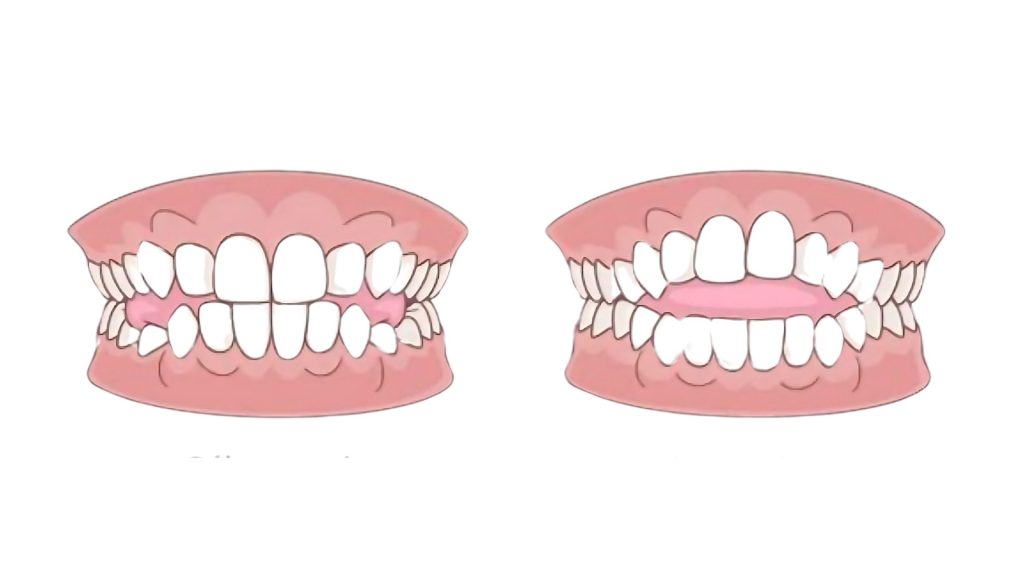Dr. Vinay Kumar provides specialized care for conditions that affect oral development and function, including persistent tongue thrusting habits and the need for frenectomy procedures. These seemingly distinct issues are often interconnected, impacting bite alignment, speech, and overall oral health. Our integrated approach focuses on addressing the root cause to ensure optimal development and lasting results.


Dr. Vinay Kumar provides specialized care for conditions that affect oral development and function, including persistent tongue thrusting habits and the need for frenectomy procedures. These seemingly distinct issues are often interconnected, impacting bite alignment, speech, and overall oral health. Our integrated approach focuses on addressing the root cause to ensure optimal development and lasting results.

Tongue thrusting, or reverse swallow, is a myofunctional habit where the tongue pushes forward against or between the front teeth during swallowing, speech, or even at rest. While common in infants, if it persists into childhood or adulthood, it can lead to several orthodontic and speech problems:
Open Bite: The most common consequence, where the front teeth do not meet due to the tongue’s constant pressure.
Protruding Teeth: Front teeth may flare outward.
Speech Impediments: Lisping or difficulty with “s” and “z” sounds.
Breathing Issues: Can sometimes be associated with mouth breathing.
Causes can include:
Heredity
Enlarged tonsils/adenoids (affecting breathing/swallowing)
Allergies (leading to mouth breathing)
Thumb or pacifier sucking
Tongue-tie (ankyloglossia)

A frenectomy is a minor surgical procedure that removes or modifies a frenum – a small fold of tissue that connects two parts of the mouth. There are two primary types often relevant in orthodontics:
Labial Frenectomy (Upper Lip Frenum): Removes the tissue connecting the upper lip to the gum between the two upper front teeth. An overly large or low-attached labial frenum can contribute to a midline diastema (gap between front teeth) or restrict lip movement.
Lingual Frenectomy (Tongue-Tie Release): Removes the tissue (lingual frenum) connecting the underside of the tongue to the floor of the mouth. An overly short or tight lingual frenum (known as tongue-tie or ankyloglossia) can restrict tongue movement, impacting speech, breastfeeding in infants, and sometimes contributing to tongue thrusting.
The procedure is quick, often performed with local anesthesia, and involves precise removal or reshaping of the frenum, sometimes using a laser for minimal discomfort and faster healing.

Tongue thrusting, or reverse swallow, is a myofunctional habit where the tongue pushes forward against or between the front teeth during swallowing, speech, or even at rest. While common in infants, if it persists into childhood or adulthood, it can lead to several orthodontic and speech problems:
Open Bite: The most common consequence, where the front teeth do not meet due to the tongue’s constant pressure.
Protruding Teeth: Front teeth may flare outward.
Speech Impediments: Lisping or difficulty with “s” and “z” sounds.
Breathing Issues: Can sometimes be associated with mouth breathing.
Causes can include:
Heredity
Enlarged tonsils/adenoids (affecting breathing/swallowing)
Allergies (leading to mouth breathing)
Thumb or pacifier sucking
Tongue-tie (ankyloglossia)

A frenectomy is a minor surgical procedure that removes or modifies a frenum – a small fold of tissue that connects two parts of the mouth. There are two primary types often relevant in orthodontics:
Labial Frenectomy (Upper Lip Frenum): Removes the tissue connecting the upper lip to the gum between the two upper front teeth. An overly large or low-attached labial frenum can contribute to a midline diastema (gap between front teeth) or restrict lip movement.
Lingual Frenectomy (Tongue-Tie Release): Removes the tissue (lingual frenum) connecting the underside of the tongue to the floor of the mouth. An overly short or tight lingual frenum (known as tongue-tie or ankyloglossia) can restrict tongue movement, impacting speech, breastfeeding in infants, and sometimes contributing to tongue thrusting.
The procedure is quick, often performed with local anesthesia, and involves precise removal or reshaping of the frenum, sometimes using a laser for minimal discomfort and faster healing.
There’s a significant connection between tongue thrusting and frenectomy:
An overly tight lingual frenum (tongue-tie) can restrict proper tongue elevation, forcing the tongue forward during swallowing, thus contributing to tongue thrusting.
In some cases, a high or thick labial frenum can not only cause a diastema but also encourage the tongue to push into that gap, exacerbating a thrust.
Addressing the frenum through a frenectomy can be a crucial step in correcting underlying structural issues that contribute to or worsen a tongue thrusting habit, allowing orthodontic treatment and myofunctional therapy to be more effective.

There’s a significant connection between tongue thrusting and frenectomy:
An overly tight lingual frenum (tongue-tie) can restrict proper tongue elevation, forcing the tongue forward during swallowing, thus contributing to tongue thrusting.
In some cases, a high or thick labial frenum can not only cause a diastema but also encourage the tongue to push into that gap, exacerbating a thrust.
Addressing the frenum through a frenectomy can be a crucial step in correcting underlying structural issues that contribute to or worsen a tongue thrusting habit, allowing orthodontic treatment and myofunctional therapy to be more effective.


Dr. Vinay Kumar’s approach to tongue thrusting and frenectomy is comprehensive and often involves a multidisciplinary team:
Diagnosis: Thorough examination to identify the cause of tongue thrusting or the problematic frenum.
Myofunctional Therapy (Habit Correction): For tongue thrusting, this involves exercises to retrain the tongue’s resting posture and swallowing pattern. Dr. Vinay Kumar may recommend specific orthodontic appliances (like a tongue crib or habit breaker) to discourage the thrust and guide the tongue.
Frenectomy Referral/Coordination: If a frenum is identified as a contributing factor, Dr. Vinay Kumar will coordinate with a skilled oral surgeon or periodontist to perform the frenectomy. This minor procedure typically allows for freer movement of the tongue or lips, facilitating orthodontic treatment and myofunctional therapy.
Orthodontic Correction: Following or alongside habit correction and frenectomy, braces or clear aligners are used to correct any bite issues (like open bites or flaring teeth) that have developed.

Dr. Vinay Kumar’s approach to tongue thrusting and frenectomy is comprehensive and often involves a multidisciplinary team:
Diagnosis: Thorough examination to identify the cause of tongue thrusting or the problematic frenum.
Myofunctional Therapy (Habit Correction): For tongue thrusting, this involves exercises to retrain the tongue’s resting posture and swallowing pattern. Dr. Vinay Kumar may recommend specific orthodontic appliances (like a tongue crib or habit breaker) to discourage the thrust and guide the tongue.
Frenectomy Referral/Coordination: If a frenum is identified as a contributing factor, Dr. Vinay Kumar will coordinate with a skilled oral surgeon or periodontist to perform the frenectomy. This minor procedure typically allows for freer movement of the tongue or lips, facilitating orthodontic treatment and myofunctional therapy.
Orthodontic Correction: Following or alongside habit correction and frenectomy, braces or clear aligners are used to correct any bite issues (like open bites or flaring teeth) that have developed.
| Aspect | VKOrthodontist’s Approach | General / Less Specialized Approach |
|---|---|---|
| Understanding of Oral Habits | Deep understanding of oral habits and their impact on dental development. | May have a more generalized understanding of habit impact. |
| Collaborative Care | Collaborative approach with oral surgeons and speech therapists when necessary. | Collaboration might be less integrated or initiated only in complex cases. |
| Diagnosis Precision | Offers precise diagnosis. | Diagnosis may be less comprehensive or precise. |
| Habit-Breaking Strategies | Provides effective habit-breaking strategies. | May offer more generic habit-breaking advice. |
| Frenectomy Coordination | Seamless coordination for frenectomy procedures. | Coordination for frenectomy might be less streamlined. |
| Treatment Plan | Ensures a holistic treatment plan. | Treatment plans may be more focused on individual issues rather than holistic. |
| Outcome Focus | Leads to stable, healthy, and beautiful results. | Outcomes may be functional but potentially less stable or aesthetically optimized. |
Smiles Transformed, Confidence Restored – Real Stories from Happy Patients!
Tongue thrusting is when the tongue pushes against or between front teeth during swallowing or at rest.
A frenectomy is a minor surgery to remove or modify a small tissue fold (frenum) in the mouth, like under the tongue or upper lip.
A tight frenum (tongue-tie) can cause tongue thrusting; a frenectomy can free the tongue for proper swallowing.
Treatment corrects bite problems, improves speech, enhances oral hygiene, and supports healthy facial development.
Dr. Vinay Kumar uses precise diagnosis, myofunctional therapy, and coordinates frenectomy procedures with specialists for holistic care.
Smiles Transformed, Confidence Restored – Real Stories from Happy Patients!
Tongue thrusting is when the tongue pushes against or between front teeth during swallowing or at rest.
A frenectomy is a minor surgery to remove or modify a small tissue fold (frenum) in the mouth, like under the tongue or upper lip.
A tight frenum (tongue-tie) can cause tongue thrusting; a frenectomy can free the tongue for proper swallowing.
Treatment corrects bite problems, improves speech, enhances oral hygiene, and supports healthy facial development.
Dr. Vinay Kumar uses precise diagnosis, myofunctional therapy, and coordinates frenectomy procedures with specialists for holistic care.
Dr. Vinay Kumar’s deep understanding of oral habits and their impact on dental development, combined with his collaborative approach with oral surgeons and speech therapists when necessary, makes Dr. Vinay Kumar an ideal choice. We offer precise diagnosis, effective habit-breaking strategies, and seamless coordination for frenectomy procedures, ensuring a holistic treatment plan that leads to stable, healthy, and beautiful results.
Address:
Delma St – Al Danah –
Zone 1 – Abu Dhabi – United Arab Emirates
Phone: +971 58 581 2423
Hours: Monday to Sunday (9 am–9 pm)
Address:
Delma St – Al Danah –
Zone 1 – Abu Dhabi – United Arab Emirates
Phone: +971 58 581 2423
Hours: Monday to Sunday (9 am–9 pm)